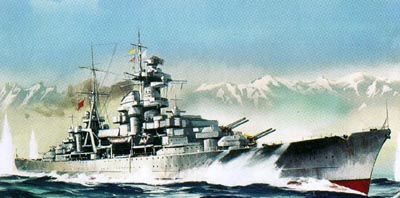The Second World War - The Invasion Of Norway And Denmark - World War Two - Battle Of France
The Invasion of Norway and Denmark
On April 9 1940 German troops commenced operation Weserübung and occupied Denmark and invaded Norway. It was the first action that ended the 'Phoney War'. Hitler wanted to ensure the supply of iron ore from Sweden through the Norwegian port of Narvik, which was ice free all year round unlike the Swedish ports. He also wanted ports along the Atlantic from which the German Navy could operate; at the time German planners could not have foreseen the success of Fall Gelb, the offensive against France, and so did not anticipate the French Atlantic ports being available. To gain access to the Atlantic German U-Boats and Capital ships had to navigate the straits of Dover or around the northern tip of Scotland, both dangerous prospects given the nearness to Royal Navy bases. The Norwegian ports were therefore of strategic importance at the time. Denmark was occupied simply because it facilitated the invasion of Norway.
Denmark
Denmark offered little resistance; Denmark had a low population compared to Germany and it was relatively small and flat making an effective defense difficult.
The German plan called for ground troops to move in three columns from over the German Danish border and move across the peninsular at the same time as troops were being landed at Copenhagen and airborne troops were securing airfields. The Danish air force was virtually wiped out on the ground, one reconnaissance aircraft taking off at the time of the attack was shot down, its two man crew being killed.
A hasty conference of Danish government and army chiefs concluded that, with threats of the imminent bombing of Copenhagen, Denmark's position was untenable and they chose to surrender. The German campaign lasted barely six hours.
Norway
Norway was invaded in the early hours of April 9. The German plan called for amphibious landings by six task forces at Oslo, Bergen, Narvik, Trondheim, Kristiansand and Egersund.. Fallschrimjager were tasked with capturing airfields and other key locations. However, events directly linked to the Norwegian campaign were happening earlier than this.
Naval Actions
On April 4 British submarines were deployed in the Skagerrak, the area of sea between Denmark and Norway, as screen to act as an early warning of German movements. On April 5 the Royal Navy had a battle group of twelve destroyers led by Admiral William Whitworth in HMS Renown. in the area around northern Norway but weather was bad and covered the German approach.
The destroyer HMS Glowworm had been detached from the main force to search for a man overboard when on the morning of April 8 it happened across the German force headed for Trondheim, led by the heavy cruiser Admiral Hipper. Glowworm was hit by gunfire and, because it could not hope to outrun Hipper, Glowworm's Captain decided to ram her; inflicting serious damage but exploding as a result. Glowworm had broken radio silence and reported her circumstance but failed to complete the message. The Admiralty were, therefore, aware that something was happening, but not quite sure what.; the Admiralty concluded it was an attempted breakout into the Atlantic and ordered Renown to move to Glowworm's last position.
On the morning of April 8, the Polish submarine ORP Orzeł sank the German ship Rio de Janerio covertly carrying troops to Norway. The discovery of uniformed men and war material amongst the wreckage was reported to the Admiralty.
Late on April 8 the Admiralty ordered Whitworth to move towards the group detected near Trondheim. At around 04:00 on April 9 Renown encountered the German battleships Scharnhorst and Gneisenau. Renown scored hits on the German ships but they were faster than Renown and made their escape at speed.
Seaborne assaults

The German Heavy Cruiser Blucher was sunk by a determined defense at Bergen
The seaborne assaults on May 9 by the six German groups met with mixed results. Groups 1, 2, 4 and 6, at Narvik, Trondheim, Kristiansand and Egersund, encountered little resistance. Group 3 at Bergen found a more resolute opposition that managed to seriously damage the light cruiser Königsberg and damaging the cruiser Karlsruhe and training ship Bremse. Group 5 at Oslo faced the most serious opposition; the heavy cruiser Blücher being sunk and the heavy cruiser Lützow being damaged. Nevertheless all groups achieved their objectives.
German consolidation
The next phase in the German plan was to link up all the various units. The Allies meanwhile focused on recovering Trondheim in preparation for a counter-offensive. The Allies plan was thwarted by a mixture of Norwegian troops surrendering and the German Air Force dominating the skies allowing the Stukas free reign to attack the allied ground troops; denying the Allies the possability to execute any effective action.
Evacuation
The Allies had finalized plans to evacuate Norway by May 24. On June 7 the plan was put into execution. The Norwegian Government, King Haakon VII and the Crown Prince went into exile aboard the cruiser Devonshire. By June 8 all allied troops had been evacuated.
Surrender
Formal resistance continued until June 10 when the regular Norwegian troops surrendered, but a resistance movement hampered the German occupying forces throughout the war.
